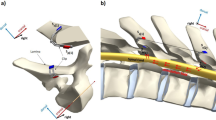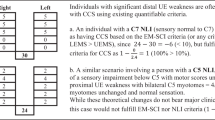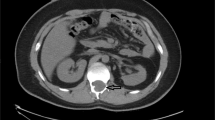Abstract
Introduction
The risk of spinal cord damage after Spinal Cord Stimulator (SCS) implant is a very rare event. In our case report, the patient was affected by a progressively worsening spinal stenosis due to SCS compression.
Case report
The authors describe a progressive paraparesis in a 58-year-old woman with a long history of back pain and multiple spine surgeries. Computed tomography (CT) outlined vertebral canal stenosis corresponding to an electrode array implanted in T9. A posterior T8–T10 spinal cord decompression with explanation of the SCS device was performed and a partial neurological improvement was observed immediately postoperative.
Discussion
Spinal cord stimulation has been used since 1967 for the treatment of refractory chronic pain, particularly failed back surgery syndrome (FBSS) and complex regional pain syndrome (CRPS). Still, the mechanism underlying its function is not completely clear. Moreover, complications are mainly related to implant dysfunction and the risk of direct and indirect spinal cord compression is described as exceptional in the literature. Our aim is to describe the case SCS device spinal cord direct compression and its surgical treatment.
Similar content being viewed by others
Log in or create a free account to read this content
Gain free access to this article, as well as selected content from this journal and more on nature.com
or
Data availability
The data that support the findings of this study are available from the corresponding author upon reasonable request.
References
Brinzeu A., Cuny E., Fontaine D., Mertens P., Luyet P., Djian M. et al. Spinal cord stimulation for chronic refractory pain: long‐term effectiveness and safety data from a multicentre registry. Eur J Pain. 2019;23:1031–1044
Turner JA, Loeser JD, Deyo RA, Sanders SB. Spinal cord stimulation for patients with failed back surgery syndrome or complex regional pain syndrome: a systematic review of effectiveness and complications. Pain. 2004;108:137–47.
Fontaine D. Spinal cord stimulation for neuropathic pain. Rev Neurol. 2021;177:838–42. https://doi.org/10.1016/j.neurol.2021.07.014.
Sdrulla AD, Guan Y, Raja SN. Spinal cord stimulation: clinical efficacy and potential mechanisms. Pain Pract. 2018;18:1048–67.
Soldati E. National Italian Register of implantable systems for spinal cord stimulation (SCS): analysis of preliminary data. Neuromodulation. 2002;5:7–15.
Author information
Authors and Affiliations
Contributions
The corresponding author collected all data and wrote the paper, all authors contributed to the revision and final editing of the article.
Corresponding author
Ethics declarations
Competing interests
The authors declare no competing interests.
Ethical approval
No ethical approval was necessary as all treatments are routinely used worldwide and represent the best standard of care.
Additional information
Publisher’s note Springer Nature remains neutral with regard to jurisdictional claims in published maps and institutional affiliations.
Supplementary information
Rights and permissions
Springer Nature or its licensor holds exclusive rights to this article under a publishing agreement with the author(s) or other rightsholder(s); author self-archiving of the accepted manuscript version of this article is solely governed by the terms of such publishing agreement and applicable law.
About this article
Cite this article
Pallotta, M.L., Lovi, A., Luca, A. et al. Spinal cord stimulator medullary compression—a very rare SCS complication and surgical treatment. Spinal Cord Ser Cases 8, 84 (2022). https://doi.org/10.1038/s41394-022-00550-6
Received:
Revised:
Accepted:
Published:
DOI: https://doi.org/10.1038/s41394-022-00550-6



